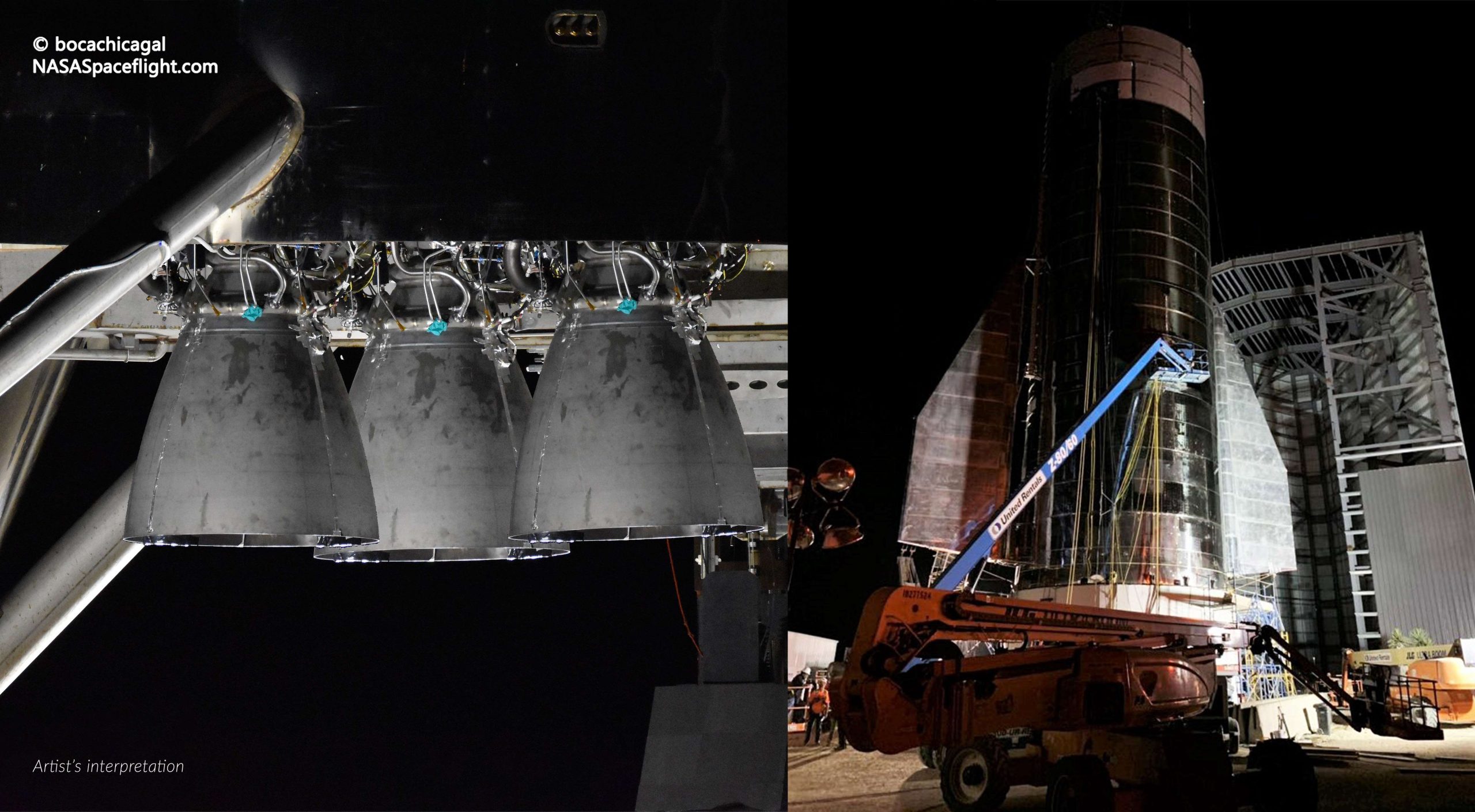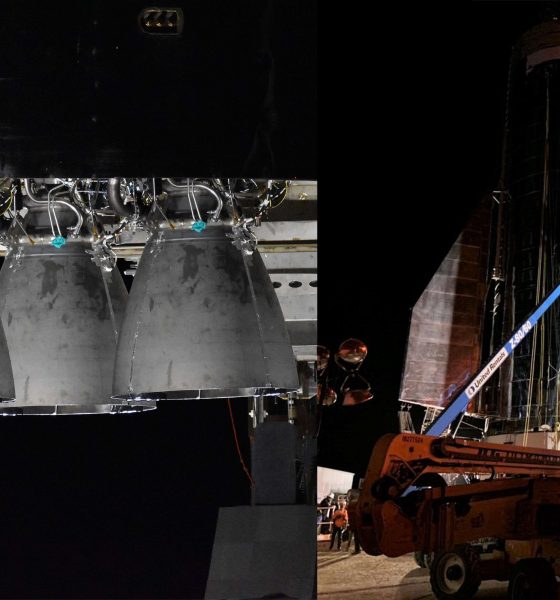

News
SpaceX’s Starship Mk1 rocket already has three Raptors installed, says Elon Musk
In a few late-night tweets, SpaceX CEO Elon Musk offered a rare view inside the company’s Boca Chica Starship fabrication building and revealed that technicians had already installed all three Raptor engines on Starship Mk1.
SpaceX is in the midst of a frenetic few weeks of activity as technicians and engineers – some likely flown in from Florida – work around the clock to ready Starship Mk1 for its first flight tests. Musk is also scheduled to present an official update on Starship’s latest design on September 28th and likely wants to have a complete Starship (or nearly so) as an imposing backdrop for the media event.
Bottom half of Starship at night. Top half with forward fins & header tanks probably stacks on Wednesday. Three Raptors already installed. pic.twitter.com/haq3m1V1Wm— Elon Musk (@elonmusk) September 23, 2019
The news that SpaceX has already installed all three Raptor engines on Starship Mk1 comes as a surprise, an exceedingly rare instance thanks to near-continuous coverage provided by several local residents and 24/7 livestreams. On September 22nd, at least one Raptor engine was spotted arriving in Boca Chica, but no onlookers noticed engine installation operations.
Capable of producing 600+ metric tons (1.3M lbf) of thrust, those three Raptors were attached to a custom-fabricated thrust structure that was installed inside Starship Mk1 on August 14th, barely a month ago. There’s a chance that one or several of the Raptors installed are nonfunctional spares, but it’s likely that the engines installed are ready for flight and have completed static fires in McGregor, Texas. As such, they could very well be the engines that will power Starship’s inaugural flight tests, the first of which will involve a suborbital launch to an altitude of more than 20 km (12.5 mi).
Musk says that Starship Mk1’s three segments could be stacked atop each other as early as Wednesday, September 25th, also implying that the spacecraft prototype’s nose section should be fully outfitted with batteries, header tanks (small propellant tanks), its own actuating fins, and more in the next 2-3 days.
Additionally, Musk published a brief video inside SpaceX’s recently-completed Boca Chica Starship fabrication building, the only semi-permanent building the company has built at its South Texas facilities. Featuring an abstract series of mirror-like steel panels that created a bit of a house-of-mirrors effect, Musk says the items pictured will be combined to form Starship Mk1 wing hinges and raceways, an external tunnel used for plumbing and cable routing.
SpaceX installed both of Starship Mk1’s aft wings/flaps over a 48 hour period, wrapping up the basic mechanical integration on September 22nd. Work has started on the prototype’s raceway and the frames of the first two wing hinge covers were spotted on Friday. As of midnight local time on September 23rd, SpaceX technicians were welding propellant feed lines to the outside of Starship’s tank section and installing the rocket’s header tanks – small secondary propellant tanks – inside its pointed nose section.
Check out Teslarati’s Marketplace! We offer Tesla accessories, including for the Tesla Cybertruck and Tesla Model 3.

News
Tesla starts showing how FSD will change lives in Europe
Local officials tested the system on narrow country roads and were impressed by FSD’s smooth, human-like driving, with some calling the service a game-changer for everyday life in areas that are far from urban centers.

Tesla has launched Europe’s first public shuttle service using Full Self-Driving (Supervised) in the rural Eifelkreis Bitburg-Prüm region of Germany, demonstrating how the technology can restore independence and mobility for people who struggle with limited transport options.
Local officials tested the system on narrow country roads and were impressed by FSD’s smooth, human-like driving, with some calling the service a game-changer for everyday life in areas that are far from urban centers.
Officials see real impact on rural residents
Arzfeld Mayor Johannes Kuhl and District Administrator Andreas Kruppert personally tested the Tesla shuttle service. This allowed them to see just how well FSD navigated winding lanes and rural roads confidently. Kruppert said, “Autonomous driving sounds like science fiction to many, but we simply see here that it works totally well in rural regions too.” Kuhl, for his part, also noted that FSD “feels like a very experienced driver.”
The pilot complements the area’s “Citizen Bus” program, which provides on-demand rides for elderly residents who can no longer drive themselves. Tesla Europe shared a video of a demonstration of the service, highlighting how FSD gives people their freedom back, even in places where public transport is not as prevalent.
What the Ministry for Economic Affairs and Transport says
Rhineland-Palatinate’s Minister Daniela Schmitt supported the project, praising the collaboration that made this “first of its kind in Europe” possible. As per the ministry, the rural rollout for the service shows FSD’s potential beyond major cities, and it delivers tangible benefits like grocery runs, doctor visits, and social connections for isolated residents.
“Reliable and flexible mobility is especially vital in rural areas. With the launch of a shuttle service using self-driving vehicles (FSD supervised) by Tesla in the Eifelkreis Bitburg-Prüm, an innovative pilot project is now getting underway that complements local community bus services. It is the first project of its kind in Europe.
“The result is a real gain for rural mobility: greater accessibility, more flexibility and tangible benefits for everyday life. A strong signal for innovation, cooperation and future-oriented mobility beyond urban centers,” the ministry wrote in a LinkedIn post.
News
Tesla China quietly posts Robotaxi-related job listing
Tesla China is currently seeking a Low Voltage Electrical Engineer to work on circuit board design for the company’s autonomous vehicles.

Tesla has posted a new job listing in Shanghai explicitly tied to its Robotaxi program, fueling speculation that the company is preparing to launch its dedicated autonomous ride-hailing service in China.
As noted in the listing, Tesla China is currently seeking a Low Voltage Electrical Engineer to work on circuit board design for the company’s autonomous vehicles.
Robotaxi-specific role
The listing, which was shared on social media platform X by industry watcher @tslaming, suggested that Tesla China is looking to fill the role urgently. The job listing itself specifically mentions that the person hired for the role will be working on the Low Voltage Hardware team, which would design the circuit boards that would serve as the nervous system of the Robotaxi.
Key tasks for the role, as indicated in the job listing, include collaboration with PCB layout, firmware, mechanical, program management, and validation teams, among other responsibilities. The role is based in Shanghai.
China Robotaxi launch
China represents a massive potential market for robotaxis, with its dense urban centers and supportive policies in select cities. Tesla has limited permission to roll out FSD in the country, though despite this, its vehicles have been hailed as among the best in the market when it comes to autonomous features. So far, at least, it appears that China supports Tesla’s FSD and Robotaxi rollout.
This was hinted at in November, when Tesla brought the Cybercab to the 8th China International Import Expo (CIIE) in Shanghai, marking the first time that the autonomous two-seater was brought to the Asia-Pacific region. The vehicle, despite not having a release date in China, received a significant amount of interest among the event’s attendees.
Elon Musk
Elon Musk and Tesla AI Director share insights after empty driver seat Robotaxi rides
The executives’ unoccupied tests hint at the rapid progress of Tesla’s unsupervised Robotaxi efforts.

Tesla CEO Elon Musk and AI Director Ashok Elluswamy celebrated Christmas Eve by sharing personal experiences with Robotaxi vehicles that had no safety monitor or occupant in the driver’s seat. Musk described the system’s “perfect driving” around Austin, while Elluswamy posted video from the back seat, calling it “an amazing experience.”
The executives’ unoccupied tests hint at the rapid progress of Tesla’s unsupervised Robotaxi efforts.
Elon and Ashok’s firsthand Robotaxi insights
Prior to Musk and the Tesla AI Director’s posts, sightings of unmanned Teslas navigating public roads were widely shared on social media. One such vehicle was spotted in Austin, Texas, which Elon Musk acknowleged by stating that “Testing is underway with no occupants in the car.”
Based on his Christmas Eve post, Musk seemed to have tested an unmanned Tesla himself. “A Tesla with no safety monitor in the car and me sitting in the passenger seat took me all around Austin on Sunday with perfect driving,” Musk wrote in his post.
Elluswamy responded with a 2-minute video showing himself in the rear of an unmanned Tesla. The video featured the vehicle’s empty front seats, as well as its smooth handling through real-world traffic. He captioned his video with the words, “It’s an amazing experience!”
Towards Unsupervised operations
During an xAI Hackathon earlier this month, Elon Musk mentioned that Tesla owed be removing Safety Monitors from its Robotaxis in Austin in just three weeks. “Unsupervised is pretty much solved at this point. So there will be Tesla Robotaxis operating in Austin with no one in them. Not even anyone in the passenger seat in about three weeks,” he said. Musk echoed similar estimates at the 2025 Annual Shareholder Meeting and the Q3 2025 earnings call.
Considering the insights that were posted Musk and Elluswamy, it does appear that Tesla is working hard towards operating its Robotaxis with no safety monitors. This is quite impressive considering that the service was launched just earlier this year.








